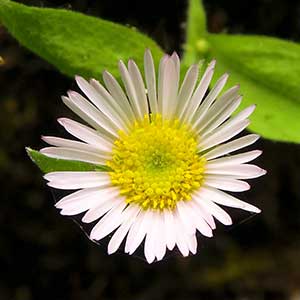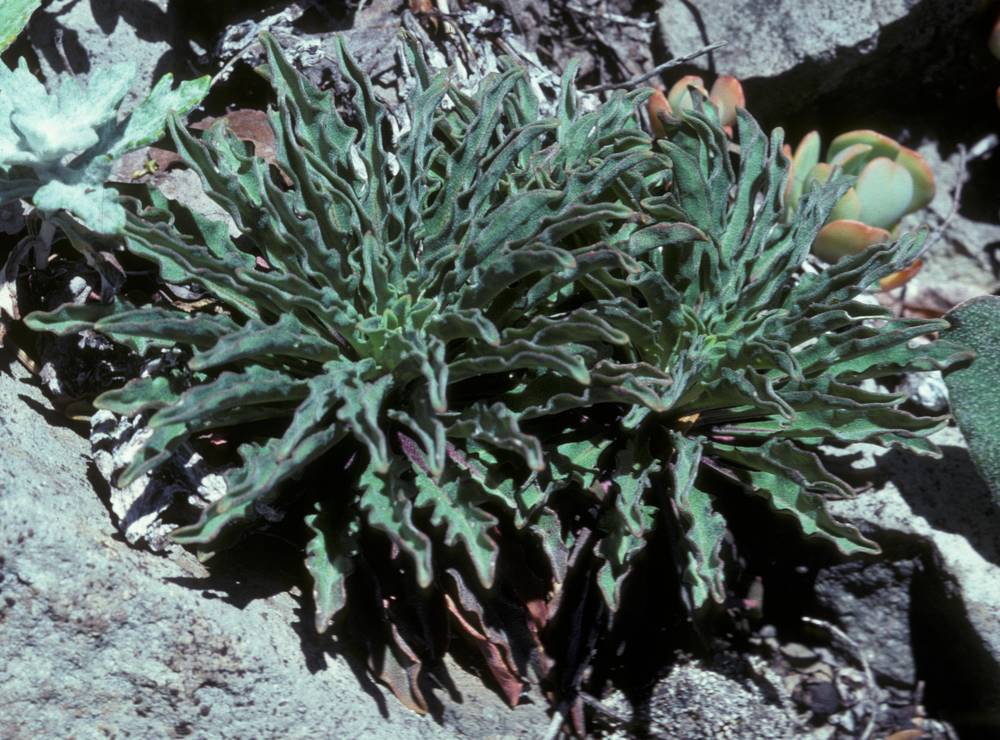Erigeron oreganus
Asteraceae
Gorge daisy, gorge fleabane, Oregon fleabane
aster family, composite family, sunflower family
decumbent to erect; hirsute with unequal hairs, sparsely glandular.
woody or herbaceous throughout, or only bases of stems woody and persistent.
opposite, alternate, or whorled;
basal; cauline, or both;
blades simple or compound, sometimes highly dissected;
margins often toothed or lobed, sometimes spiny.
persistent, obovate, 15–90 × 5–20 mm;
margins coarsely serrate to shallowly lobulate;
surfaces sparsely to moderately hirsute to strigose.
obovate to elliptic; little or not reduced distally;
surfaces sparsely to moderately hirsute.
usually in determinate arrays, or heads solitary; terminal and/or axillary.
4–7 × 9–15 mm.
sometimes absent or fused into bur-like structures.
smooth or pitted, sometimes bristly.
stamens 5, attached to tube walls by slender filaments;
ovaries inferior;
styles usually 1, 2-branched, florets of 3 forms: (1)
30–60, pink to purple;
rays 4–5 × 0.5–1 mm.
forming circle at outer margins of receptacles, usually functionally pistillate or sterile;
rays usually 3-toothed; (2)
corollas 3–5 mm.
functionally bisexual or staminate, occupying whole receptacle or central part when ray florets present;
petals fused, forming a tube with (4)5 terminal teeth;
stamens 5;
styles 1; (3)
in 2–3 series, pale green with dark green medial stripe;
surfaces remotely hirsute, strongly stipitate-glandular.
in 1–many series;
margins overlapping or fused to form a cup.
2–3 mm, moderately strigose;
inner pappi of several unbarbed to weakly barbellate twisted bristles.
single-seeded achenes, indehiscent, often columnar or fusiform, occasionally beaked;
pappi (when present) composed of few to many scales; awns, or bristles, persistent or deciduous.
1–4, radiate.
composed of few to many small florets.
(when present) throughout receptacles or only at outer margins.
functionally bisexual; occupy entire receptacle;
lower portions tubular; upper strap-shaped, usually spreading, 5-toothed at tips;
stamens 5;
styles 1.
Erigeron oreganus
Asteraceae
Shady cliffs, rocky slopes, crevices. Flowering May–Aug. 100–400 m. Casc. WA. Native.
This uncommon species is found only in the Columbia River Gorge.
Worldwide. ~1100 genera; 141 genera treated in Flora.
Asteraceae is sometimes still referred to by its former name, Compositae, and its members are often called composites referring to the characteristic inflorescence that appears to be a single flower but is in fact a composite of small flowers (florets) in a compact head. Reproduction in Asteraceae is usually sexual by cross- or self-pollination, but some genera are facultatively or obligately asexual, propagating vegetatively by means of rhizomes, stolons, or bulblets, or making seeds with an asexually formed embryo that is genetically identical with the parent plant (apomixis). A number of terms are used specifically in Asteraceae. Heads that have an outer ring of florets with flat, elongated corollas are called radiate. If all disc florets are of one kind and ray florets are absent, the heads are discoid. Plants with highly reduced ray corollas may be keyed as discoid. Heads with two kinds of florets (outer usually pistillate and inner bisexual) are disciform. Plants with heads composed of only strap-shaped ray florets are ligulate. The straps are called ligules. Ray and disc florets are called sterile if they don’t form a fruit or fertile if they do. If only a pistil is present, the floret is pistillate, if both pistil and anthers are present and functional, it is bisexual, and if only the anthers are functional, it is staminate. Dioecious genera have functionally unisexual heads on separate plants. The structure at the center of a head to which the florets are attached is the receptacle. Its shape varies from flat to convex, hemispheric, conic, cylindric, or globose. There are often bracts on the receptacle, situated among the florets; these are called paleae (sometimes referred to as chaff). They sometimes occur only in a ring just inside the involucres, or they may be totally absent. They may subtend the florets or may wrap around to enclose them and, at maturity, enclose the resulting fruits. Heads are usually surrounded by a group of bracts known collectively as the involucre. The individual bracts are termed phyllaries. Additionally, sometimes a group of bracts resembling an outer calyx are present. These are referred to as the calyculus (pl. calyculi). Fruits sometimes carry a long, linear extension called a beak. The pappus (pl. pappi) is a modified calyx present at the summit of an achene. It is composed of scales, bristles, or awns, or a combination of these. Pappus scales take various forms, and sometimes small, united or separate scales form a ring at the summit called a crown. Awns are a stouter form of bristle and may be tapered and thickened toward the base. The scales may taper toward the tip or be blunt and lacerate, and sometimes the midrib of the scale extends as an awn or bristle. Feathery awns or bristles are termed plumose. Awns and bristles may also be barbed with sharp projections. The pappus may be persistent at maturity or deciduous. Within Oregon, Asteraceae is the largest and most diverse plant family, with 552 described taxa. This easily surpasses the taxa counts of our next largest families (Poaceae, 333; Fabaceae, 268; Brassicaceae, 201). Due to the large number of taxa within Asteraceae, ranks other than genus are sometimes employed or referenced. The ranks include supertribes, tribes, and subfamilies, with tribes the most commonly used. Most tribes share some common morphological characteristics, but exceptions occur. As a result, we have not intentionally divided the taxa in the following key into this rank. A number of Asteraceae species are important food, horticultural, or medicinal plants. Lettuce, artichokes, and the sweetener stevia are all members of this family. Common sunflower (Helianthus annuus) is the only Oregon native composite commonly grown for food. Familiar garden plants include dahlias, marigolds, asters, and chrysanthemums. Chamomile (Matricaria chamomilla), safflower (Carthamus tinctorius), and milk thistle (Silybum marianum) are non-natives that may occasionally escape cultivation in the state. Many non-native species have become significant weeds in Oregon. The ubiquitous dandelion (Taraxacum officinale) and daisy (Leucanthemum vulgare) are familiar plants of lawns and disturbed areas. Some species are economically damaging enough to agricultural and range land to be listed as noxious weeds by the Oregon Department of Agriculture. These include yellow starthistle (Centaurea solstitialis), tansy ragwort (Senecio jacobea), Canada thistle (Cirsium arvense), diffuse knapweed (Centaurea diffusa), Scotch thistle (Onopordum acanthium), spiny cocklebur (Xanthium spinosum), and woolly distaff thistle (Carduus lanatus). The numerous small florets in compact heads make Asteraceae inflorescences ideal for butterfly pollination, and species of Cirsium, Anaphalis, Eucephalus, and others are also host plants for certain species of butterflies. High nectar production in some species attracts many other pollinators as well.
James Riser, Stephen Meyers
- Local floras:
OR
- Local Web sites:
Flora NW,
PNW Herbaria
WildflowerSearch
iNaturalist (observations)
- LBJ Wildflower Center
- SEINet
- Plants of the World Online
- Encyclopedia of Life
- Wikipedia
- Google Image Search




